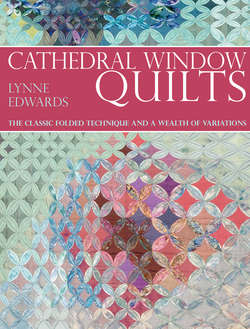Читать книгу Cathedral Window Quilts - Lynne Edwards - Страница 24
На сайте Литреса книга снята с продажи.
Using the Sewing Machine
ОглавлениеWhen I first explored Cathedral Window I treated it as a hand technique from start to finish. I used to construct the folded squares by hand using a steam iron, but over the years I have switched to the envelope method and to stitching by machine, although all the stitching may be done by hand if preferred. I like the machine for this part of the job because it is more secure and speeds up the tedious preliminary processes, giving me more time for the delicious hand-work with the windows.
I have always joined the folded squares together by oversewing or whip stitching the folded edges by hand, much like English patchwork over papers. This is a process that I really enjoy, finding the gentle oversewing very restful and therapeutic. I am very aware, however, that such activities are not everyone’s pleasure. I realized that if I wanted Cathedral Window to have as wide an appeal as possible, I needed to find alternative ways of doing the preliminary stages more quickly by machine – that way both the hand workers and the machinists can explore the technique in the medium that they most enjoy. Although I believe that the final stage of stitching the rolled edge over the added window fabric is essentially a hand process, I know that clever machinists will enjoy themselves perfecting it by machine. Well, they would do, wouldn’t they? Meanwhile what I have done is take the stitching together of the folded background squares or rectangles and offer a machined method as an alternative to oversewing by hand (see Joining Square Blocks by Machine, page 20). For the machining, a basic straight stitch with an accurate 1⁄4in (6mm) seam allowance is all that is required, so even an ancient hand machine would do. Use a new 80/11 size needle for medium-weight cotton fabrics or a 70/9 for lightweight fabric.
